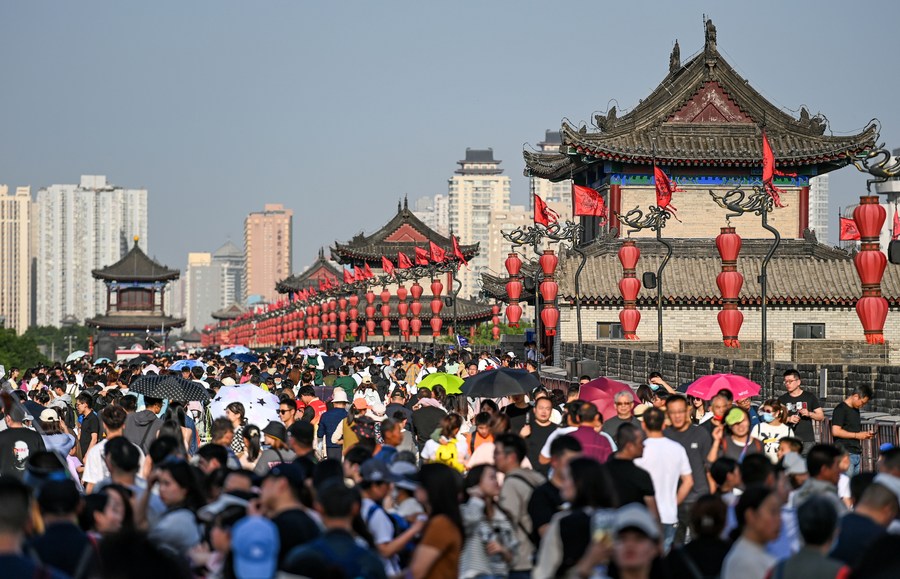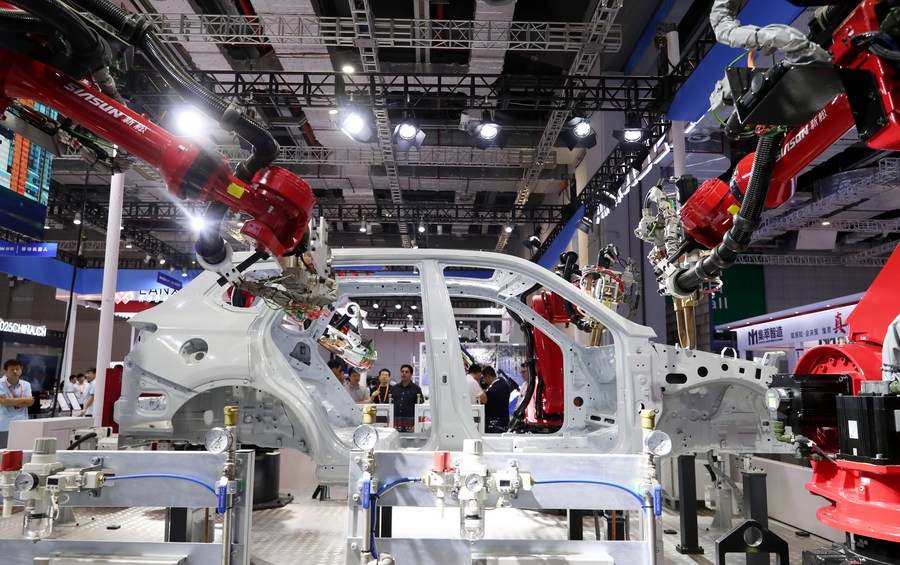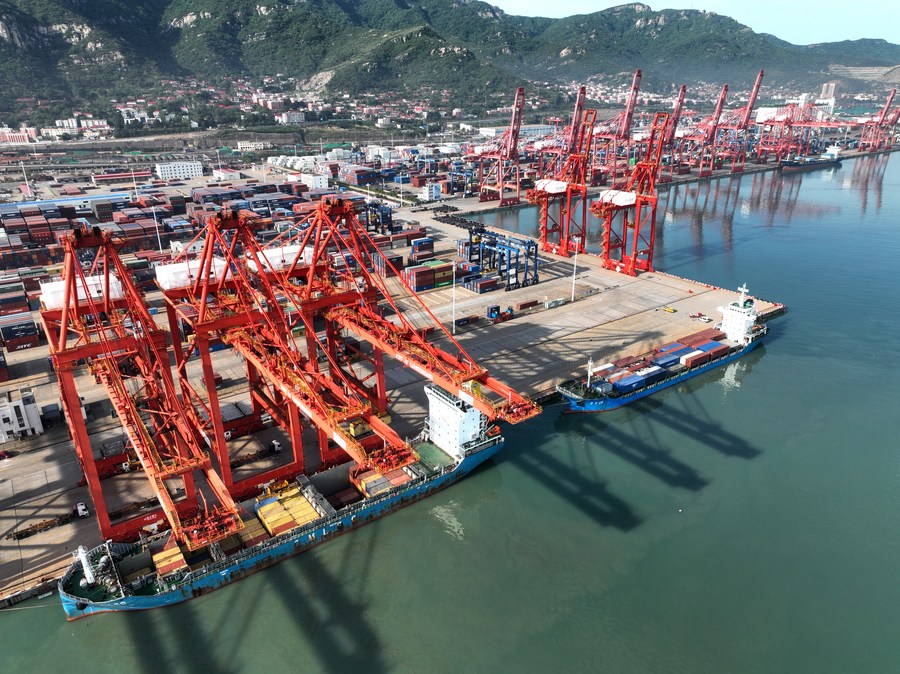Typical tricks Western media employ to discredit China's economy

People visit the ancient city wall scenic spot in Xi'an, northwest China's Shaanxi Province, April 30, 2023. (Photo by Zou Jingyi/Xinhua)
The use of such tricks is pervasive as deep-seated ideological bias has left many Western journalists incapable of objectively assessing China's economic performance, and certain media outlets are even driven by profits to resort to smearing and sensationalism.
BEIJING, Sept. 20 (Xinhua) -- A slew of sensational yet biased Western media reports about China's economy have raised eyebrows recently, drawing attention to some of the old tricks employed by those media outlets to disgrace the Chinese economy.
Double standards, selective blindness, false narratives, manipulation of statistics, to name just a few, are among the handy tricks some Western media employ in depicting China's economic landscape, as they scheme to tarnish the performance of the world's second-largest economy.
The use of such tricks is pervasive as deep-seated ideological bias has left many Western journalists incapable of objectively assessing China's economic performance, and certain media outlets are even driven by profits to resort to smearing and sensationalism.
BLATANT DOUBLE STANDARDS
Some Western media's adoption of "double standards" when reporting on China's economy has led to a collective bias, which in turn has yielded reports with similar angles and extreme viewpoints.
As a result, those media outlets often vacillate between their so-called "China collapse" theory and "China threat" theory, depending on China's economic performance at any given moment.
For instance, recent reports have suggested that China's economic slowdown is sending ripples across the economies of China's Asian neighbors. To be specific, the Wall Street Journal attributed economic challenges in countries like Japan and South Korea to China's unfavorable economic conditions, while the Financial Times claimed that the economies of South Korea, Australia, and others were hit by China's economic slowdown.
Unsurprisingly, these reports conveniently omitted the primary reasons behind these countries' challenges, such as the disruptive "decoupling" policies and market interference orchestrated by the United States.
At the same time, they chose to overlook facts such as China's average contribution to global economic growth exceeding that of the G7 from 2013 to 2021 and China's annual growth rate in recent years far surpassing the average growth rates of the world economy and developed economies.
While smearing China's economic policies, those reports deliberately avoided mentioning protectionist measures like the Inflation Reduction Act rolled out by the United States which includes high subsidy provisions.

Visitors watch a robot welding an auto body during the 23rd China International Industry Fair (CIIF) in east China's Shanghai, Sept. 19, 2023. (Xinhua/Fang Zhe)
MANIPULATION OF STATISTICS
Western media journalists often position themselves as professionals who rely on data to substantiate their claims. However, a closer look reveals that their so-called "professionalism" is dented by their manipulation of statistics in efforts to paint a rosy picture of Western economies and gloomily portray China's economy.
A telling example is The Economist's cover story on Aug. 26, which asserted that China's annualized growth rate in the second quarter was a disappointing 3.2 percent, contrasting it with a seemingly robust U.S. economy with an annualized growth rate of nearly 6 percent.
It deliberately disregarded data from China's National Bureau of Statistics, which showed a second-quarter year-on-year growth rate of 6.3 percent. Instead, it chose a quarter-on-quarter growth rate of 0.8 percent and projected this rate over the next three quarters to calculate the annualized growth rate, producing a lower figure than the year-on-year data.
In contrast, the estimate that the U.S. economy would see a "nearly 6 percent growth" was based on a prediction from a model by the Federal Reserve Bank of Atlanta, even as the bank itself had cautioned that this prediction was unreliable and exceeded market expectations by more than double.
If calculated with the method they used to assess China's economy, the U.S. annualized GDP growth in Q2 of 2023 would be 2.1 percent, lower than that of China's.
Such manipulation of data by using non-comparable statistical methods is far from professional journalism. It's misleading at best.
SELECTIVE BLINDNESS
On Aug. 30, Business Insider cited a report from J Capital Research, an investment firm, claiming that key proxies for investment, such as the amount of cement and glass being produced, have disappeared.
The report accused China of withholding crucial economic indicators, insinuating that China's economy was dire.
This has confused many analysts because, as early as Aug. 15, China's National Bureau of Statistics publicly released detailed data of key products, including cement and glass.
It makes one wonder whether the Western market consultancies and financial media outlets overlooked the data, or if they were simply selectively blind.
But one thing is for sure: to underreport the positive news about China's economy and to spread panic and misinformation is a common tactic employed by Western media to discredit China.
For instance, many Western media outlets eagerly report China's customs import and export data while largely ignoring the balance of payments data.
Analysts argue that customs data are less reliable due to differences in customs procedures between countries and significant seasonal fluctuations, while balance of payments data, with standardized global accounting practices, offer more meaningful insights.
The deep-seated reason behind this differential coverage is that China's balance of payments data have remained largely stable and its proportion to the GDP has also been within a reasonable range, making them hard to be manipulated to serve the Western media's intention to attack China.
On the other hand, customs data, prone to significant seasonal fluctuations, provide a fertile ground for negative narratives about China's economy.
China's 2022 Balance of Payments report highlighted a 19-percent growth in the goods trade surplus compared to 2021, underscoring China's resilient industrial and supply chains, and the rapid growth of its export dynamics.
The report also noted a 9-percent narrowing of the services trade deficit, primarily due to the growth of income from emerging productive services trade.
Moreover, it highlighted that foreign direct investment remained a stable channel for capital inflow, saying the long-term prospects of China's domestic economy and China's vast market continue to attract long-term international capital investments. Regrettably, Western media have ignored these positive data.

This aerial photo taken on May 9, 2023 shows the container terminal at Lianyungang Port, east China's Jiangsu Province. (Photo by Wang Chun/Xinhua)
MISLEADING EXPECTATIONS
As China optimized its pandemic prevention and control policies, the Western media have intentionally constructed a narrative suggesting that China's consumer market should experience an immediate "revenge" surge, and China's economy should maintain "strong rebounds." Any deviation from these so-called "expectations" is deliberately interpreted as China's economy being in big trouble.
Australian economist Guo Shengxiang argued that this narrative is divorced from reality and common sense. It manipulates market expectations and then leverages negative news of "falling short of expectations" to undermine market confidence, perpetuating a cycle of misleading expectations.
Chris Torrens, vice chairman of the British Chamber of Commerce in China, emphasized that China is in its first year of adjusting pandemic prevention policies. Various indicators showed its economy is gradually recovering and improving.
While the Western countries have faced numerous difficulties transitioning from adjusting anti-pandemic policies to encouraging economic recovery, the world should have confidence in and patience with China's economy, said Torrens.
Photos
Related Stories
- China mulls speeding up new industrialization
- Chinese economy naysayers to be disappointed yet again: economic planner
- Commentary: For global investors, "the next China" is China
- Intensified govt policy support set to boost economic growth in Q4
- Commentary: Why "China collapse" fearmongering destined to fail again
Copyright © 2023 People's Daily Online. All Rights Reserved.









